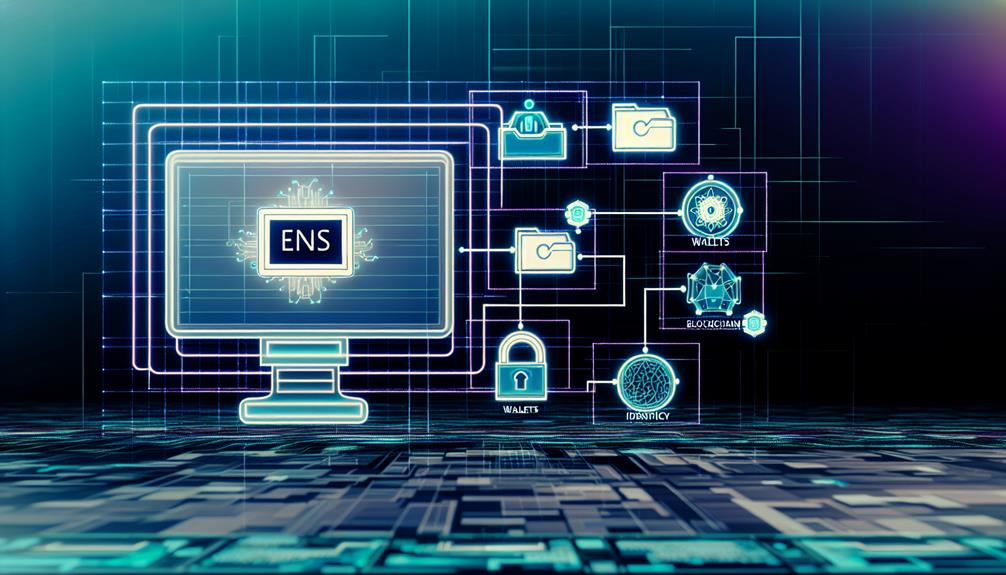Isn't it curious how something as seemingly straightforward as a domain can spark such heated debates? When it comes to .IO domains, you might find yourself questioning their safety and overall value for your business. While they can enhance your brand's visibility in the tech landscape, lurking risks like cyber vulnerabilities and ethical concerns could undermine that advantage. As you navigate these complexities, it's essential to reflect on whether the benefits truly outweigh the potential pitfalls. What factors should you be weighing in this critical decision?
IO Domains
When considering .IO domains, it's essential to understand their functionality and the specific needs they fulfill in the tech industry.
You must prioritize safety and quality, as the potential for cyberattacks and DNS misconfigurations can directly impact your operations.
Evaluating these factors will help guarantee that your choice of a .IO domain aligns with your business objectives while mitigating risks.
IO Domains and Their Functionality
Although .IO domains were initially designated for the British Indian Ocean Territory, their functionality has evolved considerably, making them a popular choice among tech startups and companies. The appeal lies in the association with "Input/Output," a concept that resonates deeply within the tech industry.
You'll find that the registration process for .IO domains is globally accessible, allowing businesses from various regions to secure unique io domain names without country-specific restrictions.
However, it's vital to be aware of the potential downsides. Notable outages, like the one in September 2017, disrupted access for nearly two hours, affecting approximately 20% of DNS queries. This highlights existing security vulnerabilities and inadequate support infrastructure, which can lead to unauthorized domain control incidents.
Such issues point to the need for improved management of .IO domains.
While .IO domains can certainly enhance branding efforts, they may not perform as efficiently in search rankings compared to more established TLDs. This can affect user trust and brand perception, making it essential to weigh these factors carefully before committing to an .IO domain for your tech company.
Importance of Safety and Quality in IO Domains
Ensuring safety and quality in .IO domains is essential for businesses that rely on them for their online presence. The historical scrutiny of .IO domains stems from notable incidents, such as the September 2017 outage affecting 20% of DNS queries for nearly two hours. This incident highlighted the vulnerabilities in the management of .IO domains, particularly by NIC.IO, which has faced criticism for inadequate support during such crises.
You need to be aware that .IO domains exhibit a higher susceptibility to cyberattacks and potential DNS misconfigurations, raising concerns about their reliability. Slower DNS resolution times can further exacerbate these issues, resulting in inconsistent server performance that can erode user trust.
However, you can mitigate some risks by leveraging available security measures like Domain Privacy Protection and DNSSEC. These options enhance overall security and protect registrant information, but they don't eliminate risks entirely.
Ultimately, prioritizing safety and quality in .IO domains is crucial for maintaining a dependable online presence, ensuring that your business can withstand potential threats and provide a seamless experience for users.
Assessing Safety in IO Domains
When evaluating the safety of .IO domains, you'll want to contemplate both the regulatory framework and the technical measures in place.
While registry regulations and features like DNSSEC enhance security, historical vulnerabilities and incidents highlight potential risks.
Understanding these factors and adopting best practices can greatly mitigate safety concerns associated with .IO domain management.
Are IO Domains Safe?
When evaluating the safety of .IO domains, you need to take into account various potential risks and threats.
While regulations and DNSSEC provide some level of protection, reports of cyberattacks and service disruptions highlight vulnerabilities that can impact reliability.
Understanding these factors is essential for making informed decisions regarding the use of .IO domains.
Analyzing Potential Risks and Threats
Evaluating the safety of .IO domains involves examining a range of potential risks and threats that can impact users.
Consider these factors:
- DNS outages can disrupt accessibility, as seen in the 2017 incident affecting 20% of queries.
- Higher susceptibility to cyberattacks raises security concerns.
- Legal uncertainties complicate ownership rights, potentially jeopardizing your user experience.
Choose wisely before registering a .IO domain.
Best Practices for Ensuring Safety
Regularly evaluating safety in .io domains is crucial to maintaining the integrity of your online presence. Implementing best practices can greatly reduce the risk of unauthorized access and enhance your domain's performance. Here are key strategies to take into account:
- Domain Privacy Protection: Verify your registrar provides this feature to safeguard your personal information, minimizing spam and phishing risks.
- Utilize DNSSEC: This protocol adds an extra layer of security, preventing unauthorized access and verifying the integrity of your DNS records.
- Monitor Domain Performance: Regularly track your domain's uptime and performance. .io domains can be prone to outages and DNS misconfigurations.
Stay proactive by keeping abreast of security updates and best practices from reputable registrars. Inadequate management can lead to vulnerabilities, leaving your domain susceptible to unauthorized control.
Think about implementing a failover mechanism or alternative domains to mitigate potential DNS outages, which have historically impacted many .io users. By adhering to these best practices, you can fortify your .io domain against threats and guarantee a safer online experience.
Evaluating Quality of IO Domains
When evaluating the quality of .IO domains, you must consider their unique advantages and disadvantages in comparison to other domain types.
While their tech-centric appeal can attract startups, the potential for cyber vulnerabilities and slower DNS resolution times raises questions about their overall reliability.
Analyzing these factors will help you determine whether .IO domains are a suitable choice for your business needs.
Is IO Domain Good?
When evaluating the quality of .io domains, you should consider several key indicators that reflect their effectiveness.
Factors like brand recognition, availability of memorable names, and trust issues play essential roles in determining whether a .io domain serves your startup well.
Additionally, the potential for increased registration costs and influence from domain squatters can impact your decision-making process.
Quality Indicators in IO Domains
In evaluating the quality of .io domains, several key indicators come into play that impact their overall effectiveness and desirability.
Consider these factors:
- Brand Identity: 78% of tech startups report improved recognition.
- Security Measures: Features like Domain Privacy Protection enhance safety.
- Performance Issues: Reports of outages and slow DNS resolution can hinder user experience.
Legal uncertainties regarding ownership also pose risks that could affect brand trust.
Comparative Analysis with Other Domain Types
.IO domains, often seen as the go-to choice for tech startups, present a mixed bag when compared to more established TLDs like .com and .net. While the io domain extension offers a modern appeal, it carries notable risks. For instance, these domains are more susceptible to cyberattacks and DNS misconfigurations, raising concerns about security.
Meanwhile, traditional domains generally provide a more stable environment.
When it comes to pricing, .IO domains can fluctuate considerably, driven by high demand and potential price increases announced for 2024. In contrast, .com and .net domains usually have more predictable pricing structures, making budgeting easier for businesses.
Additionally, .IO domains have experienced reliability issues, including notable outages that occurred in 2017. Such performance issues are less common among established TLDs, which typically enjoy robust infrastructure.
In search rankings, .IO domains often lag behind .com domains, as search engines tend to favor traditional TLDs. This could impact visibility for tech startups relying on organic traffic.
Common Misconceptions About IO Domains
You might think .io domains are solely tied to the British Indian Ocean Territory, but they're actually available for global registration and popular among tech startups.
Additionally, the belief that .io domains offer enhanced security or superior SEO performance can lead to misguided expectations.
Debunking Myths Surrounding IO Domains
Steering through the landscape of domain names often leads to confusion, especially when it comes to .io domains. One prevalent myth is that .io domains are solely tied to the British Indian Ocean Territory.
In reality, they're open for global registration, much like .ai and .co, making them accessible to anyone.
Another misconception is the inherent lack of safety associated with .io domains. The registry enforces regulations against illegal or pornographic use, establishing a baseline for safety.
However, concerns about ethical implications linger due to the historical treatment of the Chagossian community, which may deter some potential users.
Additionally, while .io domains have gained popularity and are often perceived as trendy, they're not immune to technical issues.
The significant outage in 2017 highlighted their susceptibility to DNS problems.
Future Trends in IO Domain Safety and Quality
As the landscape of .io domains evolves, you need to be aware of the emerging trends that will shape their safety and quality.
Predictions suggest enhancements in security protocols and support infrastructure from registrars will address vulnerabilities, while ongoing concerns about DNS reliability may influence your choices.
Ultimately, understanding these developments will help you make informed decisions regarding the use of .io domains for your projects.
Predictions for the Evolution of IO Domains
As you consider the future of .io domains, potential regulatory changes will likely shape the landscape considerably.
These changes may introduce stricter standards for domain registration and management, enhancing overall safety and security for users.
Potential Regulatory Changes
The growing popularity of .io domains is likely to attract increased regulatory scrutiny, leading to potential changes in ownership and usage guidelines.
You might see mandatory compliance with international data protection standards and a push for ethical practices in domain registration.
Legislative changes could also emerge, emphasizing community impact and addressing the historical context of .io domains, reshaping the digital landscape markedly.
Summary of Safety and Quality Insights
Safety and quality insights regarding .IO domains reveal a pressing need for enhanced measures to address vulnerabilities. The higher susceptibility to cyberattacks, as evidenced by significant outages like the one in September 2017, underscores the potential disruptions to service and user access. During this incident, 20% of DNS queries failed, highlighting the vital need for improved management of .IO domains to mitigate such risks.
Moreover, users frequently report slower DNS resolution times and inconsistent server performance. These issues severely impact the reliability of .IO domains, particularly during high traffic periods when performance becomes essential.
Legal uncertainties surrounding ownership and rights further complicate the landscape, posing risks for businesses and individuals who rely on these domains for branding and operational activities.
Looking ahead, the trends indicate a growing necessity for better management and support systems aimed at enhancing safety and overall quality of service for .IO domains. Addressing these vulnerabilities is fundamental not only to protect against cyberattacks but also to guarantee a stable and reliable user experience that can withstand the pressures of an increasingly digital environment.
Final Thoughts on IO Domains
Maneuvering the landscape of .IO domains reveals a complex interplay of rising popularity and underlying vulnerabilities. As tech startups increasingly adopt .io domains, user safety concerns grow, particularly around susceptibility to cyberattacks and DNS misconfigurations.
The notable DNS outage on September 20, 2017, starkly illustrated these vulnerabilities, raising questions about the reliability of .io domain management.
Looking ahead, while .io domains might remain a favored choice for startups, businesses may start weighing alternatives like .com or industry-specific TLDs. This shift could stem from an urgent need for improved stability and brand trust, especially as legal uncertainties surrounding ownership emerge. Such factors could tarnish the long-term perception of .io domains' reliability.
Moreover, ethical considerations regarding .io domains tied to contested territories may further influence consumer sentiment. As awareness of these issues grows, you'll likely see a demand for more responsible domain choices.
Ultimately, balancing the allure of .io domains with their safety and reliability concerns will be essential for businesses aiming to establish trust in an increasingly competitive digital landscape.
Frequently Asked Questions About IO Domains
When exploring .IO domains, you might've a variety of questions regarding their safety and reliability. Here are a few key concerns to contemplate:
- Security Measures: While there are regulations in place to prohibit illegal usage, .IO domains still face higher cyberattack risks compared to more established TLDs.
- Legal Uncertainties: The management and ownership of .IO domains can lead to ethical implications, raising questions about long-term stability and legal recourse.
- Modern Branding vs. Performance: Many tech startups favor .IO for its tech-savvy image, but inconsistent server performance and slower DNS resolution times can impact user experience.
Despite their appeal for modern branding, the vulnerabilities highlighted by the September 2017 outage, which affected about 20% of DNS queries, should give you pause.
Additionally, the potential for DNS misconfigurations adds another layer of risk. Thus, before committing to an .IO domain, it's crucial to weigh these considerations against your project's needs, ensuring you have robust customer support and a clear understanding of the security measures necessary to mitigate risks.




